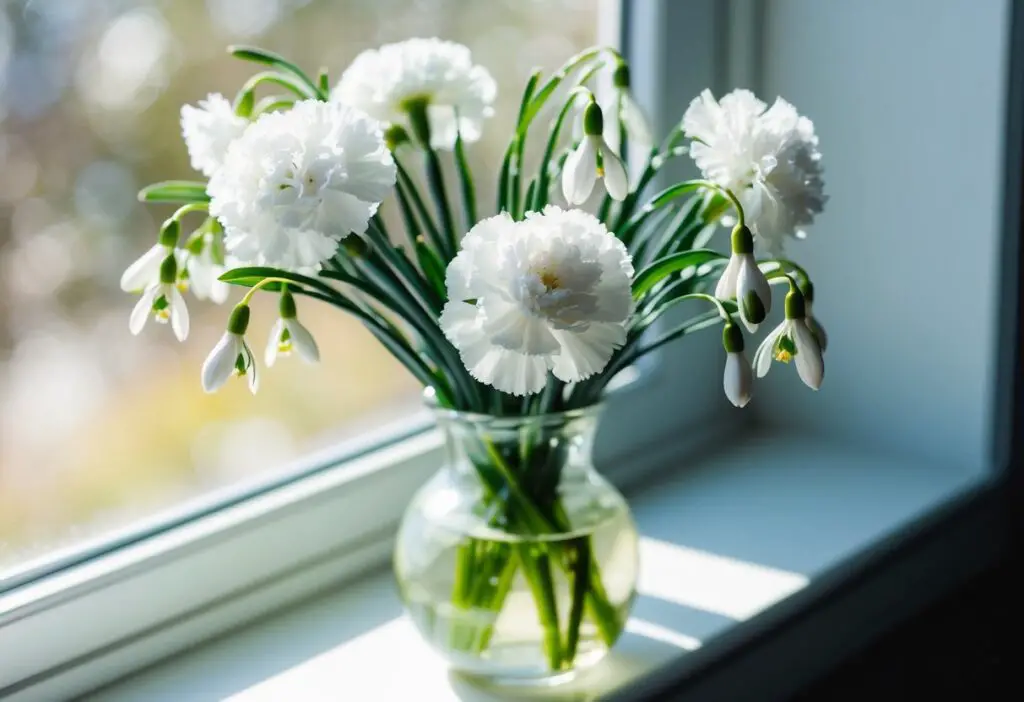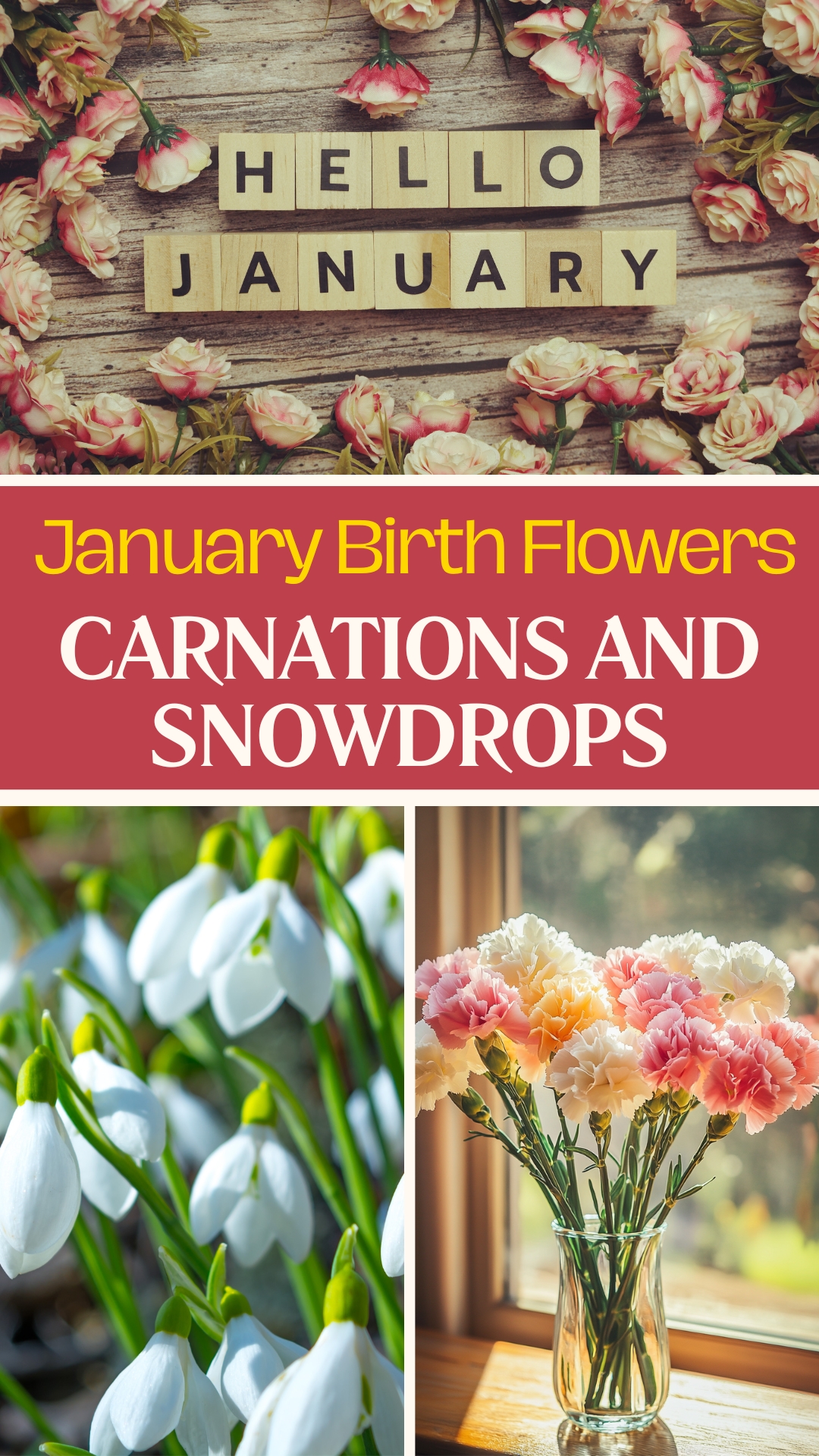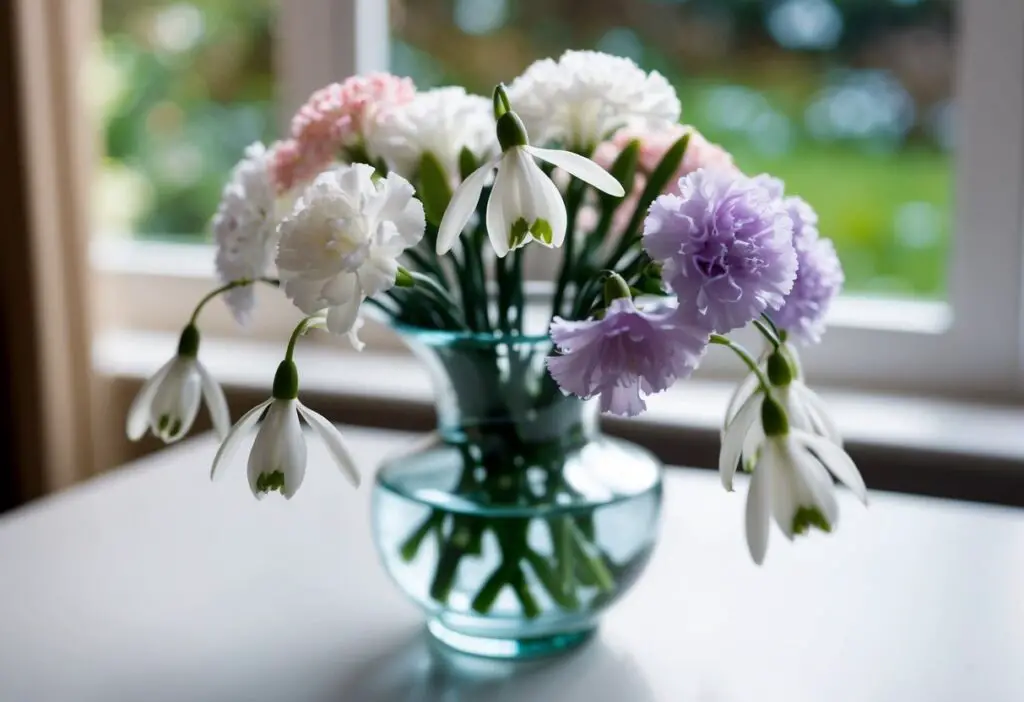Looking to explore the beauty of January’s birth flowers? You’re in luck! The carnation and snowdrop have long been cherished for their vibrant qualities and meanings. Carnations are popular with their ruffled petals and a spicy fragrance, offering shades of pink, white, and yellow. These flowers represent love, admiration, and distinction. Imagine giving someone a bouquet full of emotion!

Meanwhile, snowdrops hold a special place as they bloom right in the heart of winter. They embody hope and new beginnings and are often seen as the first sign of spring. Their delicate appearance is deceiving since they can withstand harsh winters, making them a symbol of resilience.
Together, these flowers paint a picture of hope, love, and strength. Whether you’re celebrating a birthday in January or simply appreciate winter blooms, carnations and snowdrops bring a unique charm that’s hard to resist.
Meaning and Symbolism
When you explore the birth flowers of January, carnations and snowdrops share rich symbolism and meaning. Carnations represent love and admiration, each color communicating a special sentiment. Snowdrops symbolize hope and new beginnings, often appearing as one of the first signs of spring.
Carnation Significance
Carnations are rich in meaning, with each color offering a unique message. Red carnations express love and admiration, making them perfect for Valentine’s Day. White carnations convey purity and innocence, often chosen for weddings. Pink carnations represent a mother’s love, frequently used in Mother’s Day bouquets.
Yellow carnations, however, tell a different story of disappointment or rejection. Interestingly, striped carnations symbolize regret or refusal. The carnation, regarded as the “flower of the gods,” plays a special role in expressing emotions. Whether celebrating a joyous occasion or conveying a sentiment, carnations communicate diverse meanings through their colors.
Snowdrop Symbols
Snowdrops herald the arrival of spring, symbolizing hope, purity, and new beginnings. As one of the first flowers to bloom after winter, they represent the promise of warmer days ahead. Their delicate white petals reflect purity and innocence, often appearing in gardens as a fresh start.
Symbolically, snowdrops signify renewal, making them a hopeful gift for someone going through changes. Despite their simple appearance, snowdrops carry profound meaning, signaling life’s continuous cycle. Seeing these flowers gives a sense of optimism and represents the resilience of nature.

Historical Context
Carnations and snowdrops, the birth flowers of January, aren’t just pretty blooms. They pack a punch with fascinating stories from ancient times, connecting nature with culture and beliefs.
Carnation History
Did you know that carnations have been charming people for over 2,000 years? Originating in the Mediterranean region, these flowers have traveled far and wide. The Dianthus genus, which carnations belong to, means “flower of the gods.” That’s right, these aren’t just any flowers!
In ancient Greece, carnations were a symbol of divine power, often used in coronation wreaths. Fast forward a bit, and they made their way to the United States in the 1850s. By the 1870s, over 50 varieties were available, and they’ve been a staple in the floral industry ever since. You can say carnations really know how to spread their petals!
Snowdrop Lore
Snowdrops, or Galanthus, are often the first sign of spring. Imagine this: a delicate white flower peeking through the snow—it’s like nature’s way of telling you it’s almost time for warmth. These flowers are wrapped in rich folklore.
In British tradition, snowdrops are linked to Candlemas and Imbolc, festivals that mark the beginning of spring. In the past, snowdrops were considered a symbol of purity and renewal. They’ve even been linked to healing, believed to contain properties that ward off evil. You see, snowdrops are not just pretty faces; they’re tiny, powerful symbols of hope.
Caring for Birth Flowers

Carnations and snowdrops each have their own unique needs. Whether you’re tending these flowers in your garden or as part of a bouquet, understanding their care requirements can help them thrive.
Carnation Care Tips
Carnations are hardy flowers that love sunlight. They thrive in well-drained soil and prefer a slightly alkaline pH. When planting, make sure you choose a sunny spot in your garden.
Watering should be moderate. Avoid getting the leaves wet to prevent mold. Mulching can help retain moisture and control weeds. If you’re growing them in containers, make sure there’s good drainage to keep their roots happy.
Carnations can be prone to pests like aphids. Keep an eye on them, and if you notice any bugs, a mild insecticidal soap should do the trick. Oh, and don’t forget to deadhead your flowers. Pinch off the old blooms to encourage new growth.
Snowdrop Growing Guide
Don’t be fooled by their delicate look. Snowdrops are tough little plants that bloom in wintry conditions. They can be planted in flower beds or containers, as they don’t mind cramped spaces. These flowers prefer cool temperatures and can grow in partial shade.
Plant them in well-drained soil to prevent rot. When planting bulbs, make sure they’re about 2-3 inches deep. Water them sparingly, as too much can lead to problems. Once they’re established, they don’t require much attention—just some watering during dry spells.
Want to spread the snowdrop love? After they’ve bloomed, lift and divide the clumps to plant elsewhere. It keeps the flowers healthy and extends their beauty into new areas.
Designing with Birth Flowers

Designing with birth flowers can add a personal touch to floral arrangements. Carnations and snowdrops offer unique benefits when creating bouquets or displays, symbolizing friendship and new beginnings.
Carnation Arrangements
Carnations are versatile in floral design with their multi-layered and fragrant petals. You can use them to create beautiful bouquets or as focal points in arrangements. Mixing carnations in various shades—pink, white, and yellow—adds a vibrant touch.
A handy tip for arranging carnations is to cut the stems at an angle. This helps the flowers absorb more water and stay fresh longer. Consider pairing carnations with greenery for a balanced look. These flowers also symbolize admiration and love.
Snowdrop Displays
Snowdrops bring a delicate charm to any display. They often symbolize new beginnings, making them perfect for fresh starts. Snowdrops look lovely in small vases or as part of a mixed arrangement. Their white petals stand out against greenery, providing a clean and crisp appearance.
When arranging snowdrops, it’s best to keep them in cool environments. Pairing them with simple foliage, like ferns or eucalyptus, enhances their simplicity and elegance. These displays can be ideal for early spring events or as small, thoughtful gifts.
January Flower Cultural Roles
January’s flowers, carnations and snowdrops, play special roles in various cultures. Carnations are symbols of deep emotions like love and remembrance, while snowdrops represent hope and renewal.

Carnations in Society
You might know carnations as a symbol of love and admiration. They’re often used in weddings and Valentine’s Day bouquets. The red carnation particularly stands out as a universal symbol of love. Interestingly, carnations also symbolize sympathy and are commonly seen at funerals.
Spain selected the red carnation as its national flower. The carnation has been around since the 1850s in the United States. Since then, it has become a staple in the flower industry. It’s hard to find a flower with such rich cultural roots and varied meanings.
Snowdrops in Culture
Snowdrops, those lovely white flowers, bloom even when winter lingers. Hope and rebirth perfectly capture what snowdrops represent. People in some cultures see the snowdrop as a sign of the nearing end of winter. When you spot a snowdrop, it’s like getting a little nudge saying, “Spring is coming!”
In literature and art, snowdrops often depict purity and innocence. Their appearance in early-year festivals underlines themes of renewal. Imagine walking through a snowy path and finding these tiny blossoms pushing through? That’s why many find them uplifting.
Fun Facts and Stories
Carnations and snowdrops have unique stories and facts that make them fascinating. From historical tidbits to cultural significance, these flowers have much to offer.
Carnation Trivia
Did you know carnations have been around since ancient times? They are part of the Dianthus genus, which means “divine flower” in Greek. That’s a pretty cool name, right?
Carnations were first brought to the United States in the 1850s. By the 1870s, there were already 50 different types available.
These flowers have long been associated with admiration and affection. Different colors have unique meanings. For example, pink carnations are often associated with a mother’s love, while red signifies love and affection.
On a lighter note, carnations have been popular in celebrations like weddings.
Snowdrop Anecdotes
Snowdrops are among the first flowers to bloom at the end of winter. They symbolize hope and the upcoming spring. Imagine walking in a snowy garden and suddenly seeing these delicate white blooms—quite a lovely sight!
An interesting story is about Galanthus, the scientific name for snowdrops. It means “milk flower,” named for their creamy white petals.
These flowers have also been a part of many cultural stories. In some European cultures, snowdrops are believed to bring good luck, unless you pick them and bring them indoors, which is seen as bad luck!
In literature, snowdrops often symbolize renewal and purity. These tiny flowers have brightened cold months for centuries, making them special winter blooms.
Frequently Asked Questions
Got questions about January’s birth flowers? You’re in the right spot! From the vibrant symbolism of carnations to the cool allure of snowdrops, there’s much to explore. Here’s everything you might want to know.
What do carnations symbolize when they are given as a January birth flower?
Carnations are rich in symbolism. When given as a January birth flower, they often represent love and admiration. These blooms can symbolize fascination or a deep bond, making them a thoughtful and meaningful gift for anyone celebrating a January birthday.
Can you tell me what color of carnation is typical for a January birthday?
The typical colors for January carnations can range from pink and red to white. Each color carries its own meaning. For instance, pink carnations symbolize gratitude, while red ones are often linked to deep affection. White carnations, on the other hand, symbolize purity and luck.
Are snowdrops actually available and blooming in the month of January?
Yes, snowdrops are indeed blooming in January, especially in milder climates. These charming flowers are often seen peeking through the snow, symbolizing hope and the promise of spring. Their early appearance is a remarkable sight that often marks the end of winter.
For someone with a January birthday, what is the significance of their birth flowers?
For January birthdays, carnations and snowdrops hold special significance. Carnations convey love and respect, while snowdrops symbolize hope and rebirth. These flowers together highlight the unique qualities of those born in this chilly month, blending warmth and freshness perfectly.
What are the differences between the meanings of January’s birth flowers, carnations and snowdrops?
Carnations and snowdrops have distinct meanings. Carnations, full of vibrant colors, often symbolize love, admiration, or gratitude. In contrast, snowdrops convey hope and renewal. While both flowers share a positive tone, they offer different expressive qualities to celebrate January birthdays.
How do carnation and snowdrop meanings vary across different cultures?
In some cultures, people wear carnations during festivals to represent good luck and devotion. Meanwhile, snowdrops, found in European folklore, can represent purity and innocence. These flowers hold diverse traditions and meanings around the world.
